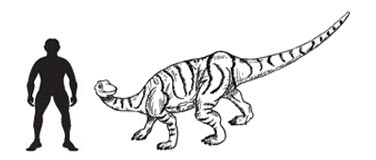Dinosaur Bones Bugged by Insects
Scientists Identify Probable Cause of Strange Marks on Dinosaur Bones
Palaeontologists have long been perplexed by dinosaur fossils with missing pieces – sets of teeth without a jaw bone, dinosaur bones that are pitted and grooved, even bones that are half gone. Now a Brigham Young University study has put forward a thesis that attempts to identify the culprits: ancient insects that munched on dinosaur bones.
Dinosaur Bones
Brigham Young University professor Brooks Britt will publish his study of these dinosaur bone-eating bugs in the May edition of the scientific journal “Ichnos”. An ichnologist is a scientist who specialises in studying trace fossils, fossils that preserve the activity of animals, such as their tracks, trails, burrows and such like. Britt’s idea for this study came when he first noticed the unique markings on the bones as an undergraduate studying at the University.
“As students we noticed these marks and thought it might be due to algae or insects and we started calling them ‘bug bites,’ just for fun,” Britt said.
Studied Insect Traces
Years later, current Brigham Young student Anne Dangerfield also wondered about the markings and teamed up with Britt to investigate the cause. They studied insect traces on the 148-million-year-old remains of a Camptosaurus, a plant-eating specimen discovered in Medicine Bow, Wyoming in 1995.
“I knew this trace was something different because I had been looking at fossil termite traces all summer, so I knew we needed to check it out,” Dangerfield said.
Their analysis revealed that beetles, from the family entomologists call Dermestidae, left the markings on the Camptosaurus. dermestid beetles still exist today and are typically brown or black, oval-shaped and feed on flesh, hair, skin or the horns of carcasses.
An Illustration of a Camptosaurus
Picture credit: Everything Dinosaur
The groove cut into the anterior of a vertebra has been made by a dermestid beetle larva.
For models and replicas of prehistoric animals: Dinosaur Models and Figures.
By studying the habitat of modern species of dermestid beetle, the team were able to make assumptions about the climate in the Late Jurassic, the time when the Camptosaurus lived. Information about the beetle’s typical habitat reveals the climate at the time of the Camptosaurus’ death probably had 60-80 percent relative humidity and a temperature of 77-86 F. By comparison, the average yearly temperature in Medicine Bow is now 43.5 F.
When the dinosaur died near what is now Medicine Bow, the carcass was consumed by other insects. The beetles then infested the Camptosaurus within months of its death.
An Insight into an Ancient Climate
In addition to shedding light on Wyoming’s ancient climate, Dangerfield and Britt’s work shows dermestid beetles existed much earlier than previously thought. The traces on this Camptosaurus predate the oldest body fossils for these beetles by 48 million years. Insect fossils are particularly rare. Their delicate bodies are not easily fossilised, although a number are trapped in tree resin, which under the right circumstances can form amber, allowing scientists to examine the organic remains trapped inside in minute detail. With beetles, occasionally entire animals are preserved but more often it is an isolated wing sheath, the hard carapace that is discovered preserved as a fossil.
“This information gives us an idea of the environment during the Jurassic period and the evolution of insects,” Dangerfield commented.
Analysing the Markings on the Bones
To analyse the markings on the bones, Britt went to his family dentist for moulding materials, allowing Britt to more quickly create replicas of the bone traces to work with.
He took the castings back to University’s Earth Science Museum where he used an electron microscope to look at the mandible markings in the bone, examining eating patterns and the width between the teeth marks. Britt and Dangerfield compared the marks to information about the mandibles of moths, termites, mayflies and dermestid beetles – all known to consume bone – to determine the identity of the insect.
“Other people have thought they have seen dermestid beetle marks, or they have interpreted termite marks as dermestids, but this paper provides a guide to identifying insects from the bone traces,” the professor said.
Britt and Dangerfield continued their research by looking at more than 7,000 bones from various quarries and found that insect traces on dinosaur bones are quite common, but dermestid beetle traces were found only on the Camptosaurus skeleton from Medicine Bow.
“Dr Britt’s work is really exciting and delves into unique aspects of palaeobiology that few scientists have yet explored,” said Eric Roberts, an expert in dinosaur decomposition who teaches at South Africa’s University of the Witwatersrand. “Insects are among the most diverse and abundant organisms on the planet, yet we know next to nothing about the fossil record of insects because of their extremely limited preservation potential.”
The above article has been compiled using material from Brigham Young University (2008, May 6). Dinosaur Bones Reveal Ancient Bug Bites.


